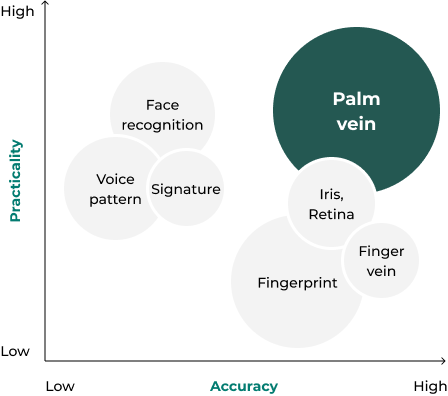
Palm vein scanning is an advanced contactless identification method on the biometric technology market. It is based on reading the pattern of the saphenous veins using infrared light absorbed by blood hemoglobin. As a result, a unique image of the vessels appears, which is processed by the sensor and checked against a database template for identity authentication.





The quality of work of biometric systems is assessed by many characteristics, the most important of which are:
• FRR (False Rejection Rate) – the rate of false rejection by the identification system
• FAR (False Acceptance Rate) – false pass rate of an unregistered user.
Research shows that Palm vein technology has the lowest FAR and FRR levels compared to other identification methods.
| Identification method |
Identification speed |
FAR | External factors leading to error |
FRR | Stability of the biometric template |
Number of read points |
| Fingerprint | 1 | 0,5% | Dirt, trauma, wet skin | 5-20% | * | 12-120 |
| Face identification |
2-5 | 0,001% | Sun, shadow | 5-20% | *** | 100-100 000 |
| On the eye retina |
2-3 | 0,0004% | Contact lenses, retinal hemorrhage, sun | 1-2% | **** | Above 4,000,000 |
| Palm vein scanning |
1 | 0,00008% | Cold hands | < 1% | ***** | Above 5,000,000 |

| Identification method | FAR (%) = | If FRR (%) = |
| Face identification | ~1.3 | ~2.6 |
| Voice template | ~0.01 | ~0.3 |
| Fingerprint | ~0.001 | ~0.1 |
| Finger venous mesh | ~0.0001 | ~0.01 |
| Iris / retina | ~0.0001 | ~0.01 |
| Venous mesh of the palm | <0.00008 | ~0.01 |